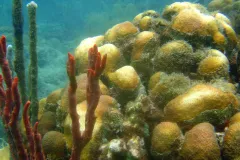A Pleasant Surprise: The Recovery of Bleached Panamanian Corals

Last September, the Citizens of the Sea blog series brought you a story of doom and gloom from the reefs of Bocas del Toro, Panama. That is the time of year we typically study -- and celebrate -- the annual birth of baby corals in the area. We arrived to find very hot water (2010 turned out to be the hottest year on record), and in the shallows the reefs had turned a ghostly white. This was the most extreme coral bleaching we had ever seen since we started our studies there in 1998. We worried that many of the bleached corals would die. Unsure of what would happen, we returned last month to check on them.
Some corals were sick and others had died, but we are happy to report that much of the bleached coral has regained its color. The reef seems to be on the road to recovery, although some corals will probably take a break from reproduction this fall while they rebuild their energy reserves.
This happy turn of events nicely illustrates the two concepts scientists use to describe how organisms and communities respond to stress - resilience and resistance. Resistance is the ability to withstand unfavorable conditions. Resilience is the ability to rebound after a catastrophe. For example, a sturdy wooden stick resists bending, but once it breaks that’s it. In contrast, a rubber band can be pulled apart easily, but once released it snaps back to its original shape (unless the pulling is too extreme). Sticks are resistant and rubber bands are resilient.
In the case of our corals in Panama, waters were so very warm that only a few were able to resist the effects of the high temperatures - most bleached. Luckily, many of the corals on our reef were resilient and able to regain their color and avoid permanent damage.
Resistance and resilience are important for entire communities too. Reefs can only recover if the survivors are able to regrow and reproduce. Clean water and healthy fish populations make recovery more likely, as they help adult corals to resist disease and baby corals to settle on the sea floor. This is why local conservation efforts remain critically important even in the face of global threats.
Editors Note: This post was co-written with Amanda Feuerstein, program coordinator in the office of the Sant Chair for Marine Science. Dr. Nancy Knowlton is the Sant Chair for Marine Science at Smithsonian’s National Museum of Natural History. Their blog series is based on Dr. Knowlton's book Citizens of the Sea, which celebrates “the Wondrous Creatures from the Census of Marine Life.”

